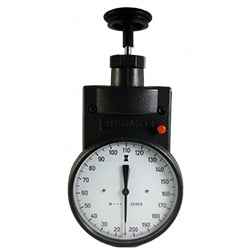Exactly how to Choose the Right Tachometer for Your Vehicle or Bike
Exactly how to Choose the Right Tachometer for Your Vehicle or Bike
Blog Article
The Significance of a Tachometer in Monitoring Engine Speed and Performance in Automotive Applications
In the realm of vehicle engineering, the tachometer stands as an essential instrument in the chauffeur's arsenal, supplying a direct home window into the inner functions of a lorry's engine. Past its feature as a mere scale of changes per min (RPM), the tachometer works as an essential device for enthusiasts and experts alike, using real-time understandings into engine performance and wellness. Recognizing the value of this gadget exceeds surface-level monitorings, diving right into the complex relationship between engine rate, power outcome, and overall driving experience. As we check out the diverse function of the tachometer in automotive applications, a much deeper recognition for its influence on vehicle dynamics and efficiency begins to emerge.
Importance of Keeping An Eye On Engine RPM
Monitoring engine RPM, or changes per minute, is a crucial facet of automobile maintenance and performance analysis. Engine RPM straight correlates with the speed at which the engine's crankshaft revolves, suggesting how quickly the engine is running.
Moreover, keeping track of engine RPM is important for efficiency assessment in auto racing and high-performance vehicles. In recap, keeping an eye on engine RPM is not just important for discovering problems but also for maximizing engine performance in various vehicle applications.

Benefits of Real-Time Data
In automotive applications, real-time data plays a critical function in giving instantaneous insights right into the performance and condition of the lorry. By continuously keeping an eye on various parameters such as engine rate, temperature, gas usage, and much more, real-time information uses countless advantages that add to enhanced effectiveness and security when driving.
Additionally, real-time data facilitates efficiency optimization by offering immediate feedback on driving routines and engine efficiency. Drivers can adjust their actions in real-time based on this information to accomplish much better gas economic climate and lengthen the life expectancy of their lorry.

In addition, real-time data plays a crucial function in contemporary automobile diagnostics, making it possible for professionals to swiftly identify and resolve malfunctions. This causes lowered downtime, reduced upkeep expenses, and inevitably, improved total lorry reliability and long life (tachometer). By utilizing next the power of real-time information, automobile stakeholders can make educated choices that positively influence both the performance and longevity of the lorry
Effect on Equipment Shifts
Effective gear changes in automobile applications significantly influence general performance and driving experience. The tachometer plays an important duty in optimizing gear shifts by providing real-time engine speed data to the chauffeur. When coming close to the redline on the tachometer, it signals the chauffeur to upshift to stop over-revving the engine and triggering possible damage. On the various other hand, downshifting at the best moment can assist keep the engine in its power band, making certain receptive velocity when needed.
Additionally, the tachometer aids in achieving smoother equipment changes, specifically in hands-on transmissions. By keeping track of engine rate, drivers can execute equipment changes at the optimum RPM array, reducing snagging my explanation motions and decreasing endure the transmission components. This accuracy in equipment changes not just enhances driving convenience yet also adds to sustain effectiveness.
Enhancing Gas Performance
Provided the vital role the tachometer plays in maximizing gear shifts for performance and engine health and wellness, it directly contributes to maximizing gas performance in vehicle applications. By giving real-time comments on engine rate, the tachometer assists drivers in maintaining one of the most efficient RPM variety for fuel economy. When vehicle drivers consistently keep track of the tachometer and change their motoring behaviors accordingly, they can avoid unneeded gas intake brought on by over-revving or carrying the engine.
In addition, the tachometer helps motorists recognize the most fuel-efficient gear to be in at any type of given moment, stopping the engine from working more challenging than necessary. In verdict, the tachometer offers as an important device in boosting gas efficiency by advertising ideal driving routines and determining areas for enhancement in the car's efficiency.

Maximizing Engine Longevity
The tachometer's role in keeping an eye on engine rate and efficiency is critical in ensuring the long life of automobile engines. Keeping track of the tachometer enables vehicle drivers to remain within the recommended RPM range for their lorry, protecting against unnecessary strain on the engine and prolonging its life expectancy.

Final Thought
Finally, the tachometer plays a vital duty in monitoring engine rate and efficiency in vehicle applications. By providing real-time information on RPM, it enables efficient gear changes, improved gas effectiveness, and taken full advantage of engine longevity. This tool is crucial for keeping optimal engine efficiency and ensuring the overall functionality of a car.
Report this page